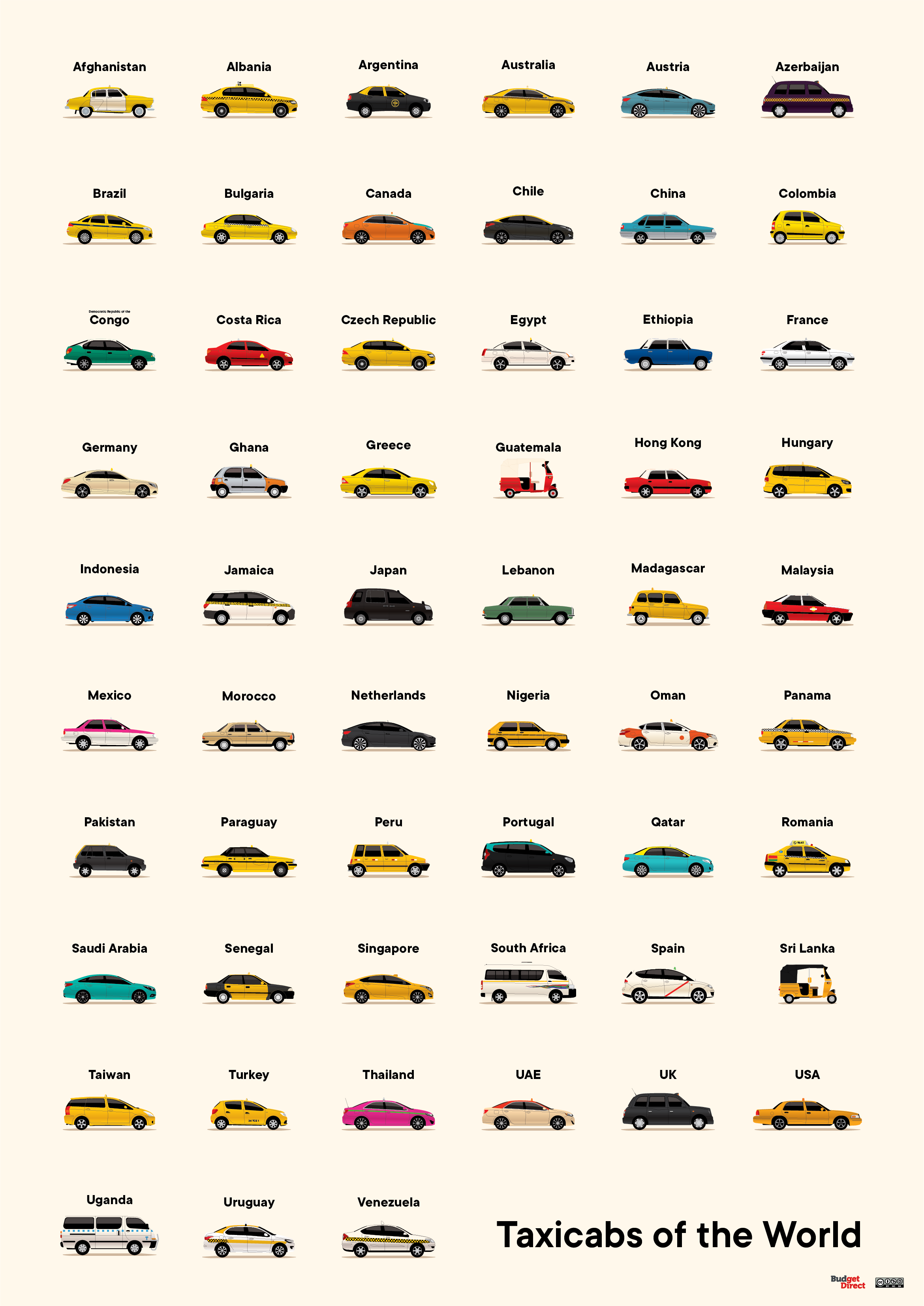Travel the world, and you will encounter multiple languages with different translations of the same word — but few words are as close to universal as the word taxi — which is short for taxicab — as many languages recognize similar pronunciations of the word as TAK-see. Even タクシー in Japanese, ταξί in Greek, and 택시 in Korean are pronounced tak-see and mean taxicab.
Taxi Cabs in Select Countries Around the World
A taxi has been defined for decades as a vehicle that is licensed to transport passengers in return for payment of a fare — but Uber, Lyft, and other ride sharing companies have broadened that definition. Still, taxi cabs come in all shapes and sizes, as they are usually influenced by the way local people travel in that particular city or town — from compact city cars for quick trips to seemingly lumbering carriers of people for transporting holiday makers and their luggage…
…but just how different are they — and which taxi cab would you like to get into first once travel restrictions due to the 2019 Novel Coronavirus are lifted?
I have been given express written permission to use the maps and the verbatim text from this article from Budget Direct, which highlights taxi cabs in 57 countries in the world. While Budget Direct has endeavored to ensure the information provided is accurate and current, it cannot guarantee it. Neither Budget Direct nor The Gate accept liability for the information which is presented in this article.

Taxicabs of the World
The humble taxicab is the bumblebee of the road. Iconic, hard-working – and under threat.
Iconic? Just think of the New York cab. Like taxis in Albania, Argentina, and Australia, its famous yellow and black design is recognized in an instant by locals and tourists alike.
But while many taxis around the world share a colour scheme with the mighty bee, yellow is not the only colour. Nor is ‘sedan’ the only shape.
“London without black cabs,” as one taxi driver told the New York Times, “would be like London without Big Ben.”
Today, Budget Direct pays tribute to the taxicab and its drivers around the world with our illustrated guide to the most iconic taxicabs on every continent.
North America
The New York taxi’s look and its much-filmed hometown make it the most famous taxi design in the world. Multiple American companies jostled for propriety of the iconic colour for their taxis, issuing lawsuits to protect their eye-catching aesthetic. But in 1970, it became a legal requirement for all regulated taxis in NYC to be yellow so passengers could tell them from unregulated cabs.
The biggest taxi company in North America is Beck in Canada. Toronto’s orange and turquoise Beck cabs might not be as famous as New York’s yellow taxis, but there sure are a lot of them.
South America
Argentinian cabs reverse the NYC colour scheme, being mostly black with yellow trim or roof. This is in tribute to the common paint job of the much-loved Peugeot 504, which was the dominant taxi vehicle in Buenos Aires and other cities in the 1980s.
Peru cabs are yellow all over, but for the Peruvian flag, they wear around their beltline. But more iconic than the colour is the Peruvian taxicab’s shape: the retro-futuristic car-box silhouette of the Daewoo Tico. Peru imported thousands of the cars in the 1990s, mostly for use as taxis. If you take a taxi in Chiclayo, you’re probably taking a Tico.
Europe
London’s black cab – officially known as the hackney carriage – is the second-best known after New York’s yellow taxi. Different manufacturers build hackney carriages to the city’s legal specifications, but The London Taxi Company (now absorbed into China’s Geely Automobiles) is responsible for today’s modern but classic-looking vehicles. In 2015, Londoners voted the black cab as their favourite London design icon.
Taxis in the Netherlands have a very cyberpunk feel. They are usually either all-white or all-black, and the law requires them to have blue license plates. The Dutch taxi fleet is slowly being upgraded with electric Tesla cars.
The taxicab fleet in Afghanistan may not be the most modern, but its retro look is full of character. It is normal to see yellow taxis with white doors. The most common models are old Toyota Corollas and Coronas, the classic Russian GAZ-21 Volga, and the boxy VAZ-2101 Zhiguli and Lada.
Licensed taxis in Dubai, the capital of the United Arab Emirates, are required to be beige. However, the colour of the roof differs according to the company. Arabia Taxi has a green roof, and the common red-roofed taxicabs are run by the Dubai Taxi Corporation.
Rest of Asia & Oceania
Hong Kong is served by three taxi services, each with its own colour and territory. The most versatile is the red ‘urban’ taxi, which can take you anywhere except the island of Lantau. Green taxis with white roofs serve the New Territories only, and a fleet of just 75 pale blue taxicabs serves Lantau. Most taxi models are imported in red, and painted if required – so even the green and blue taxis bear traces of red.
The yellow taxis commonly spotted through much of Australia may look familiar – they are descendants of the American yellow cab, first imported in 1924. Taxis in Melbourne now have to be yellow by law. It could all have been so different: Australia’s first taxis were a fleet of olive-green Renaults.
Africa
The grand old taxis you’ll see in the Moroccan city of Marrakesh are literally known as ‘grand taxis.’ But this is a French-language reference to their size, rather than the regal appearance of these vintage ochre/cream-coloured Mercedes. The ‘petit taxi’ also roams Marrakesh. It is also ochre and tends to be an older Fiat Uno or Peugeot 205.
Taxis in Madagascar don’t have to be yellow, but many of them are. What makes them particularly iconic is the shape and vintage of the vehicle. Lovingly-maintained Renault 4s and 2CVs from the 1970s roam the streets, creating an otherworldly – or other-timely – sense of decorum.
The Future of Taxis
Catching a taxi is a special experience – like staying in a hotel or eating street food. By contrast, getting an Uber always feels a bit guilty, like eating from a big-name fast-food chain or buying on Amazon.
And just as the bumblebee, the taxicab is evolving to try to survive its current challenges. While Uber has ejected its plans to create a flying or autonomous cab, artists and designers around the world are working on the next big thing in taxicabs. With a starting point as simple, ubiquitous, and necessary as the taxicab, whatever comes next is sure to be iconic.
Summary
Preferring to either rent a vehicle, take public transportation, or even to simply walk, I am typically loathe to ride as a passenger in a taxi cab, as it is a more expensive form of transportation which is not always the most convenient — but when I basically have no other choice, I will hail a taxi cab.
Other articles at The Gate which pertain to taxi cabs include:
- Watch Out For This Taxi Scam
- Add One More City to the Seven Worst Places to Hail a Taxi Cab
- Las Vegas Taxi Scams? Forget That…I Walked.
- Thinking About Taking a Taxi Cab Ride in New York on October 22?
A taxi cab rolls among the Jeepneys in Manila in the Philippines. Photograph ©2014 by Brian Cohen.

